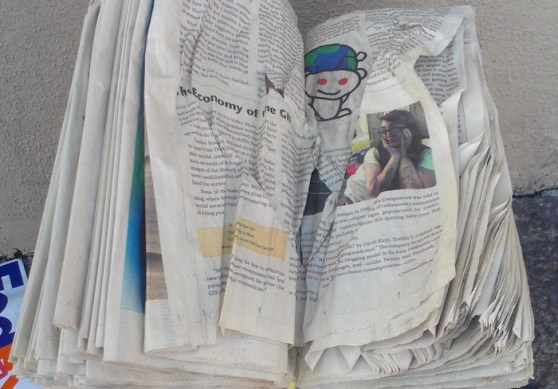In the eternal tug of war between publishers and readers, the readers have an enormous advantage right now.
But publishers are starting to pull the rope back a tiny bit toward their side.
The AP won a legal victory against the Meltwater Group, a news aggregation service, earlier this week, with a court decision that affirmed the AP’s ownership of its stories. Newspapers like the New York Times and independent bloggers like Andrew Sullivan have started experimenting, successfully, with partial paywalls: Their sites let readers view a certain number of stories for free but demand payment for the full slate.
There’s even some backlash against the multimillion-dollar sale of Summly to Yahoo earlier this week. While most commentators focused on the the youthfulness of Summly’s 17-year-old founder and the reported $30 million price tag, Time‘s Victor Luckerson wondered how Summly — another news aggregation service — got away with what it does. Essentially, Summly was aggregating and summarizing news stories for the benefit of its users without compensating the creators of those stories. As suggested by the Associated Press v. Meltwater decision, that might not even be legal.
These court decisions and paywall strategies are just skirmishes in the bigger battle.
Just as Napster did with the music industry and The Pirate Bay did with the movie industry, aggregators like Summly and Meltwater are hollowing out the old business models of the news industry and leaving destruction in their wake. But while musicians have started to figure out new business models, news publishers and moviemakers haven’t got there, yet.
Expect more experimentation
Never before in the history of humanity have we had so much content available for free. The Internet’s default mode of publishing is to offer content — news stories, videos, music, movies, whatever — for free. To the extent that there’s a commercial transaction involved, it’s usually the rather tenuous exchange of attention for advertising.
Unfortunately, advertising is a diminishing business: Print dollars turn into dimes on the web. And web dimes turn into pennies in mobile.
Now with the increased use of tools like AdBlock and Readability, it’s possible for readers to avoid even that tiny exchange, stripping out the advertisements and leaving just the content they’re interested in reading.
Don’t get me wrong. Although VentureBeat publishes an ad-supported website, I use these tools myself occasionally. I’ll turn on AdBlock when I have a less-than-ideal Internet connection (like at a conference or during my commute) and want to optimize download times. I use Instapaper frequently to clip articles that I don’t have time to read during work hours and want to save for later.
In fact, I was an early fan of Instapaper and Readability. These tools’ capability to strip out extraneous formatting from a web page and make it more readable pointed out a serious flaw with many content sites’ designs: They were simply too cluttered.
Instead, such tools suggested another way: a combination of minimalism and user control over design, which I labeled “undesign” in a 2010 post.
The message to site designers was clear: If you want people to read your stuff, make it easy for them to do so, or else get out of the way. If readers don’t like the way your site looks, they’ll use these tools to reformat them.
Since then, other tools have popped up to fill this gap. Amazon now offers a “Kindle” button that lets readers send a story directly to their Kindles. Another popular read-later service, Pocket (formerly known as Read It Later), works similarly to Instapaper, reformatting text into a cleaner, more readable version and saving it in a queue so you can read it at your convenience. Apple’s Safari browser even has an ad-free Reader option built-in.
In short, people are doing just what I predicted. The question for publishers is how to respond?
Embrace or resist?
Pocket this week added publisher tools that let content owners see statistics on who is using Pocket. That’s helpful (and VentureBeat is considering using these tools) because it at least gives the publisher some visibility into how people are using Pocket. And by encouraging people to save articles for later, it can increase the shelf life of a good story, encouraging people to read it and share it over a longer period than they otherwise would have.
Publishers have also started experimenting with different kinds of advertising. So-called “native advertising,” or sponsored posts, are easier to integrate into the content stream and harder to filter out. Done right, a sponsored post or advertorial should be just as interesting to readers as a piece of editorial.
However, native advertising can be a dangerous game. Publishing sponsored posts without sufficiently disclosing that they’re sponsored risks blowing any trust you have with your readers, as the Atlantic discovered recently when it published a post created by the Church of Scientology. Also, Google has made it clear that Google News will punish publishers who mix sponsored content in with news content without sufficiently distinguishing the two.
Yahoo is discontinuing the Summly app, but will fold its algorithms into Yahoo itself. Should publishers embrace news summaries by Yahoo or try to find ways to thwart it, either by using tech or in the courts? There won’t be an easy answer.
As readers get more and more control over the content they want to read, publishers are in a difficult place: Run alongside them, in the ever-diminishing hope of recouping revenues at some point down the line, or risk being left behind.
Old newspapers and Reddit alien photo: Dylan Tweney/VentureBeat
VentureBeat's mission is to be a digital town square for technical decision-makers to gain knowledge about transformative enterprise technology and transact. Learn More

